Exploring App-Based Taxi Movement Patterns from Large-Scale Geolocation Data
Abstract
:1. Introduction
2. Literature Review
3. Data Description
3.1. Data Source
3.2. Data Preprocessing
4. Occupied Movements
4.1. Aggregate Flow Patterns
4.1.1. Distribution of Generations and Attractions
4.1.2. Local Spatial Autocorrelations
4.1.3. Places of Importance
4.1.4. Spatial Scope of Passenger Activities
4.2. Trip Travel Patterns
5. Unoccupied Movements
5.1. Aggregate Flow Patterns
5.1.1. Places of Importance
5.1.2. Spatial Scope of Search Activities
5.2. Trip Travel Patterns
5.3. Special Analyses on Uber
6. Conclusions and Discussion
Author Contributions
Funding
Data Availability Statement
Conflicts of Interest
References
- Schaller, B. Unsustainable? The Growth of App-Based Ride Services and Traffic, Travel and the Future of New York City; Schaller Consulting: New York, NY, USA, 2017. [Google Scholar]
- Qian, X.; Zhan, X.; Ukkusuri, S. Characterizing Urban Dynamics Using Large Scale Taxicab Data. Eng. Appl. Sci. Optim. Comput. Methods Appl. Sci. 2015, 38, 17–32. [Google Scholar]
- Cai, H.; Zhan, X.; Zhu, J.; Jia, X.; Chiu, A.; Xu, M. Understanding taxi travel patterns. Phys. A 2016, 457, 590–597. [Google Scholar] [CrossRef] [Green Version]
- Guo, S.; Liu, Y.; Xu, K.; Chiu, D. Understanding passenger reaction to dynamic prices in ride-on-demand service. In Proceedings of the IEEE International Conference on Pervasive Computing and Communications Workshops, Kona, HI, USA, 13–17 March 2017. [Google Scholar]
- Kumar, D.; Wu, H.; Lu, Y.; Krishnaswamy, S.; Palanoswami, M. Understanding Urban Mobility via Taxi Trip Clustering. In Proceedings of the 17th IEEE International Conference on Mobile Data Management (MDM), Porto, Portugal, 13–16 June 2016. [Google Scholar]
- Wang, W.; Li, X.; Jiao, P.; Xu, G.; Yuan, N.; Yu, W. Exploring Intracity Taxi Mobility during the Holidays for Location-Based Marketing. Mob. Inf. Syst. 2017, 2017, 1–10. [Google Scholar] [CrossRef]
- Peng, C.; Jin, X.; Wong, K.; Shi, M.; Lio, P. Collective Human Mobility Pattern from Taxi Trips in Urban Area. PLoS ONE 2012, 7, 1–8. [Google Scholar]
- Zong, F.; Sun, X.; Zhang, H.; Zhu, X.; Qi, W. Understanding Taxi Drivers’ Multi-day Cruising Patterns. Promet-Traffic Transp. 2015, 27, 467–476. [Google Scholar] [CrossRef] [Green Version]
- Matsubara, Y.; Li, L.; Papalexakis, E.; Lo, D.; Sakurai, Y.; Faloutsos, C. F-Trail: Finding Patterns in Taxi Trajectories. In Advances in Knowledge Discovery and Data Mining; PAKDD 2013, Lecture Notes in Computer Science; Pei, J., Tseng, V., Cao, L., Motoda, H., Xu, G., Eds.; Springer: Berlin, Heidelberg, 2013; Volume 7818. [Google Scholar]
- Guo, D.; Zhu, X.; Jin, H.; Gao, P.; Andris, C. Discovering Spatial Patterns in Origin-Destination Mobility Data. Trans. GIS 2012, 16, 411–429. [Google Scholar] [CrossRef]
- Noboa, L.; Lemmerich, F.; Singer, P.; Strohmaier, M. Discovering and Characterizing Mobility Patterns in Urban Spaces: A Study of Manhattan Taxi Data. In Proceedings of the 25th International Conference Companion on World Wide Web, Montreal, QC, Canada, 11–15 April 2016. [Google Scholar]
- Ding, L.; Fan, H.; Meng, L. Understanding Taxi Driving Behaviors from Movement Data. In AGILE 2015. Lecture Notes in Geoinformation and Cartography; Springer: Cham, Switzerland, 2015; pp. 219–234. [Google Scholar]
- Dong, Y.; Zhang, Z.; Fu, R.; Xie, N. Revealing New York taxi drivers’ operation patterns focusing on the revenue aspect. In Proceedings of the 12th World Congress on Intelligent Control and Automation (WCICA), Guilin, China, 12–15 June 2016. [Google Scholar]
- Tang, L.; Sun, F.; Kan, Z.; Ren, C.; Cheng, L. Uncovering Distribution Patterns of High Performance Taxis from Big Trace Data. ISPRS Int. J. Geo-Inf. 2017, 6, 134. [Google Scholar] [CrossRef] [Green Version]
- Hoque, M.; Hong, X.; Dixon, B. Analysis of mobility patterns for urban taxi cabs. In Proceedings of the International Conference on Computing, Networking and Communications (ICNC), Maui, HI, USA, 30 January–2 February 2012. [Google Scholar]
- Pascual, O.S. Statistical Complex Analysis of Taxi Mobility in San Francisco; Universitat de Barcelona: Barcelona, Spain, 2011. [Google Scholar]
- Wang, F.; Ross, C. New potential for multimodal connection: Exploring the relationship between taxi and transit in New YorkCity (NYC). Transportation 2019, 46, 1051–1072. [Google Scholar] [CrossRef]
- Li, M.; Dong, L.; Shen, Z.; Lang, W.; Ye, X. Examining the Interaction of Taxi and Subway Ridership for Sustainable Urbanization. Sustainability 2017, 9, 242. [Google Scholar] [CrossRef] [Green Version]
- Hall, J.; Krueger, A. An Analysis of the Labor Market for Uber’s Driver-Partners in the United States; The National Bureau of Economic Research: Cambridge, MA, USA, 2016. [Google Scholar]
- Cramer, J.; Krueger, A. Disruptive Change in the Taxi Business: The Case of Uber. Am. Econ. Rev. 2016, 106, 177–182. [Google Scholar] [CrossRef] [Green Version]
- Schwieterman, J.; Michel, M. Have App Will Travel: Comparing the Price and Speed of Fifty CTA & UberPool Trips in Chicago; Chaddick Institute for Metropolitan Development at Depaul University: Chicago, IL, USA, 2016. [Google Scholar]
- Chen, L.; Mislove, A.; Wilson, C. Peeking Beneath the Hood of Uber. In Proceedings of the 2015 Internet Measurement Conference, Tokyo, Japan, 28–30 October 2015. [Google Scholar]
- Guo, S.; Liu, Y.; Xu, K.; Chiu, D. Understanding ride-on-demand service: Demand and dynamic pricing. In Proceedings of the IEEE International Conference on Pervasive Computing and Communications Workshops, Kona, HI, USA, 13–17 March 2017. [Google Scholar]
- Donovan, B.; Work, D. New York City Taxi Trip Data (2010–2013); University of Illinois at Urbana-Champaign: Urbana, IL USA, 2016. [Google Scholar]
- Blasio, B.D. For-Hire Vehicle Transportation Study; Office of the Mayor: New York, NY, USA, 2016. [Google Scholar]
- Anselin, L. Local Indicators of Spatial Association—LISA. Geogr. Anal. 1995, 27, 93–115. [Google Scholar] [CrossRef]
- Oliveau, S.; Guilmoto, C. Spatial correlation and demography: Exploring India’s demographic patterns. In Proceedings of the XXVe Congrès International de la Population, Tours, France, 18–23 July 2005. [Google Scholar]
- Matkan, A.; Shahri, M.; Mirzaie, M. Bivariate Moran’s I and LISA to explore the crash risky locations in urban areas. In Proceedings of the Conference of Network-Association of European Researchers on Urbanisation in the South, Enschede, The Netherlands, 12–14 September 2013. [Google Scholar]
- Hennemann, S.; Derudder, B. An Alternative Approach to the Calculation and Analysis of Connectivity in the World City Network. Environ. Plan. B Urban Anal. City Sci. 2014, 41, 392–412. [Google Scholar] [CrossRef] [Green Version]
- Gao, L.; Wu, J.; Rui, L. Key nodes mining in transport networks based in PageRank algorithm. In Proceedings of the Control and Decision Conference, 2009 CCDC’09, Guilin, China, 17–19 June 2009. [Google Scholar]
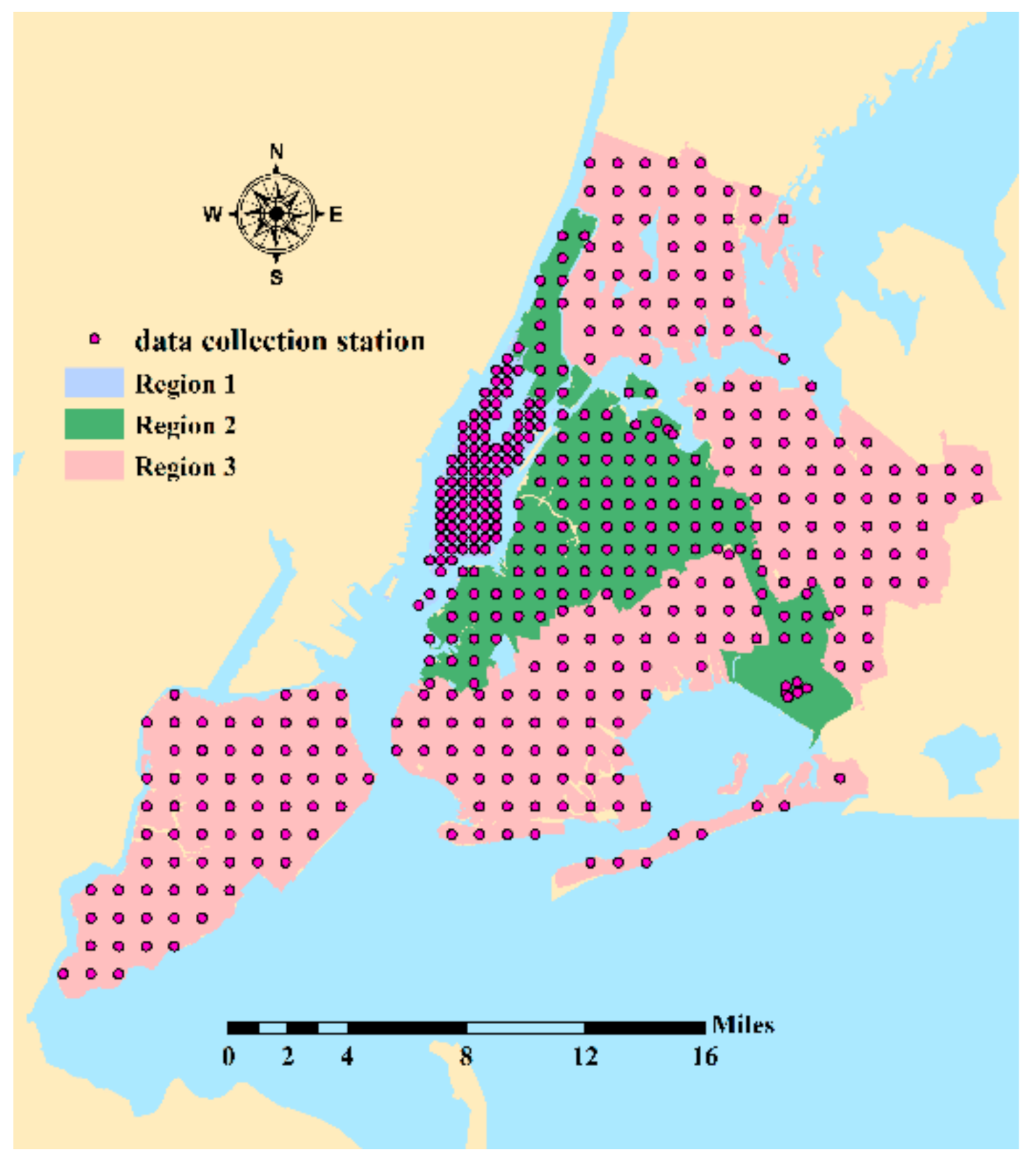
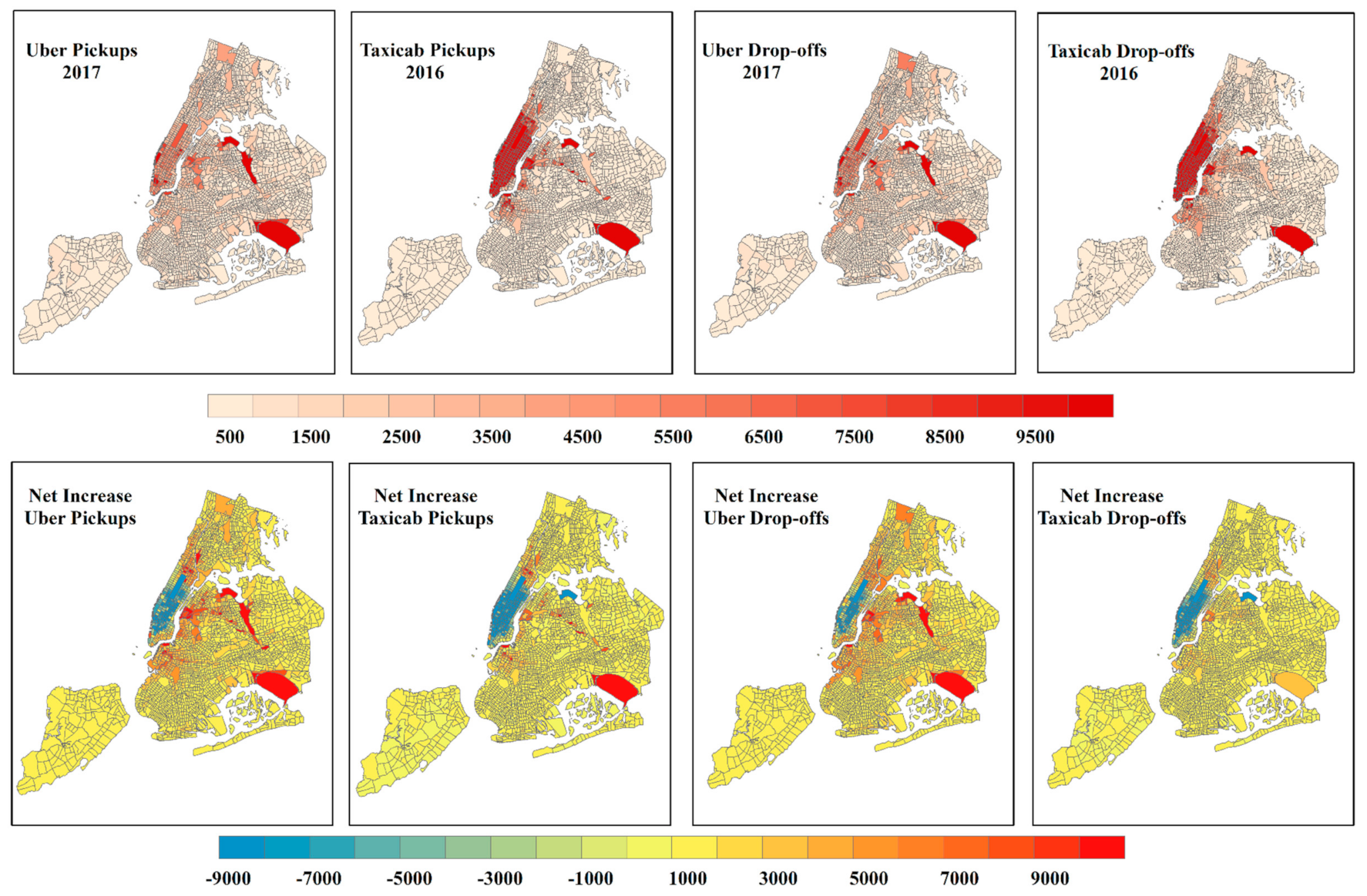

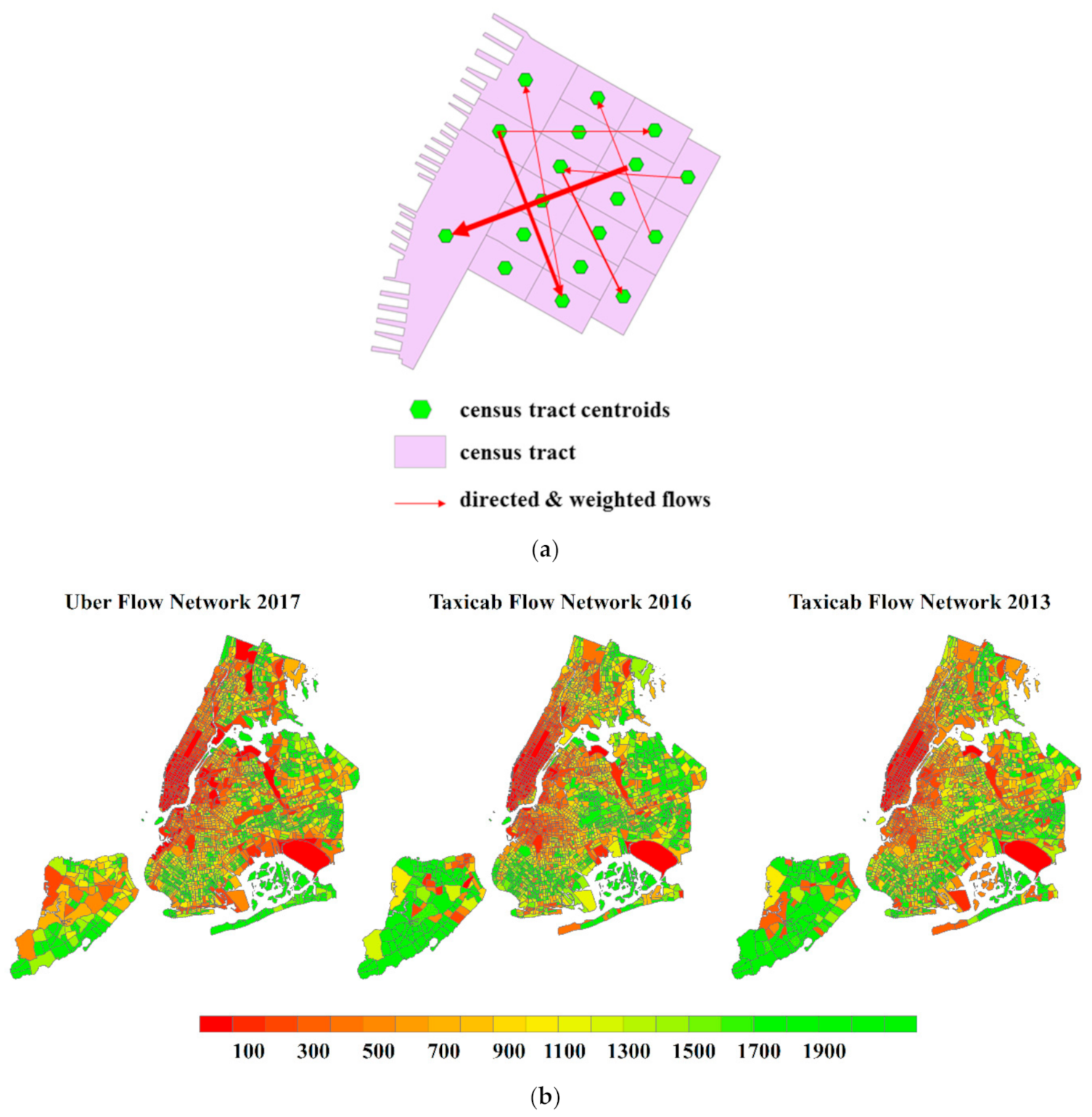
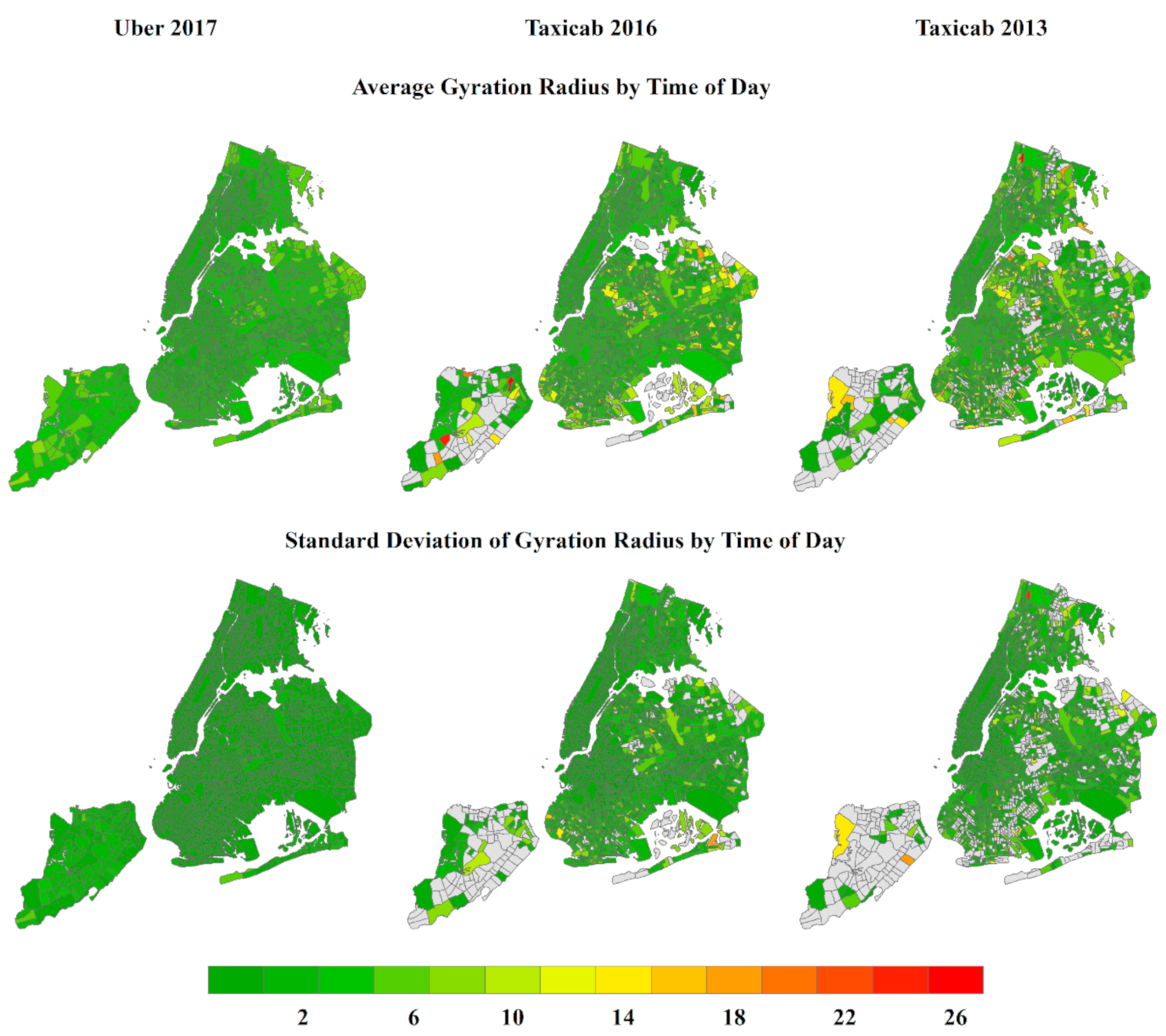
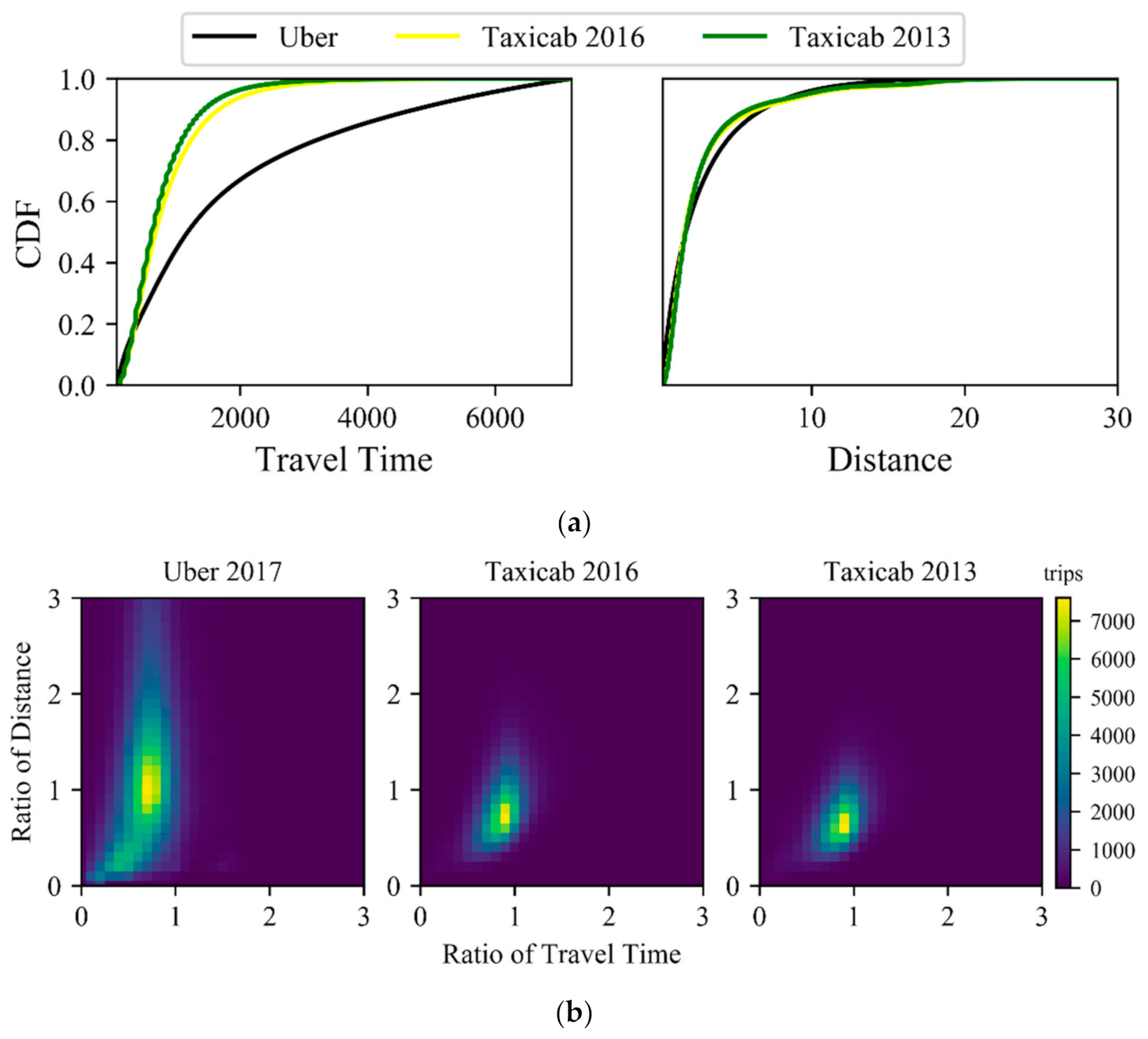
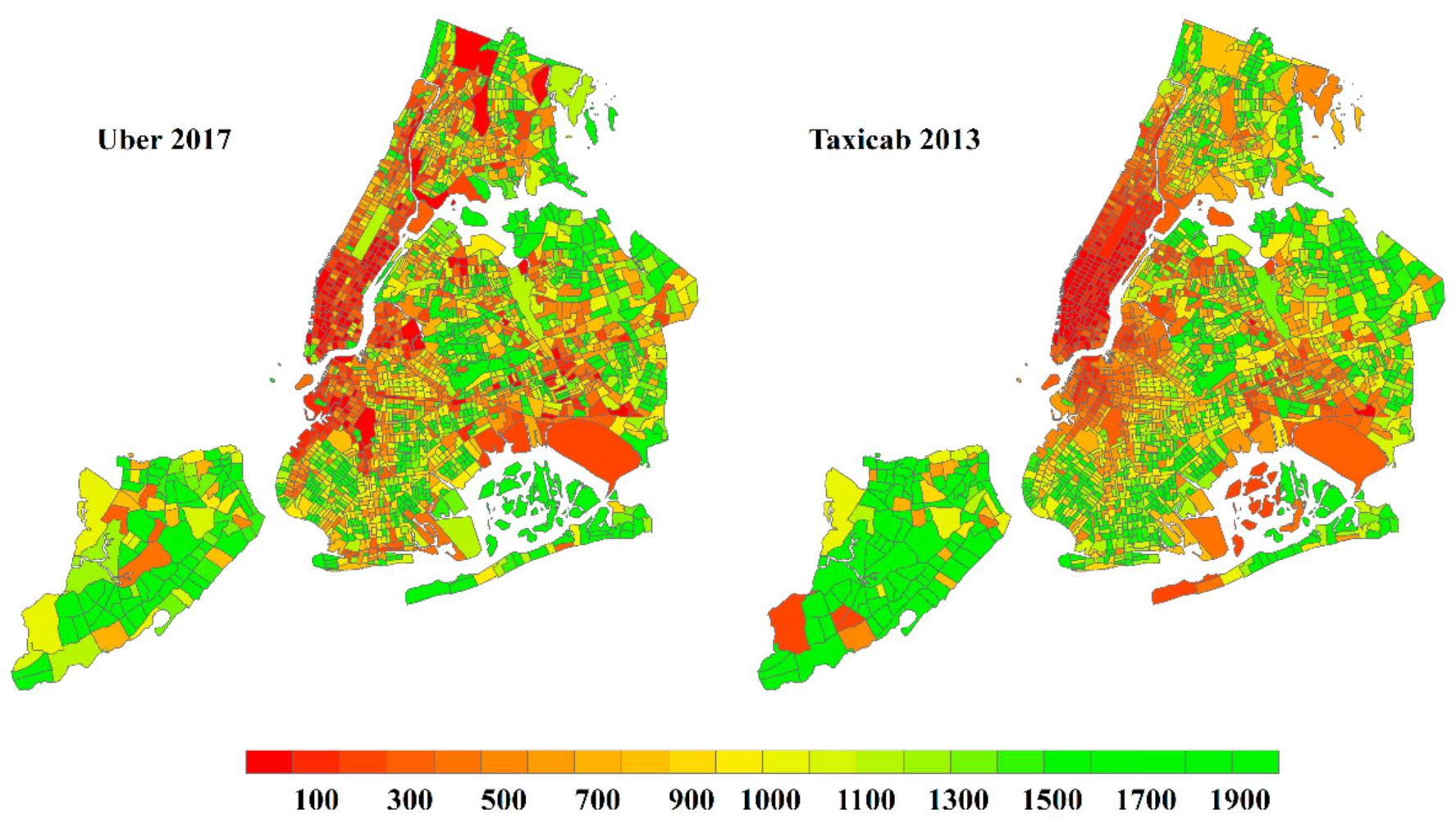
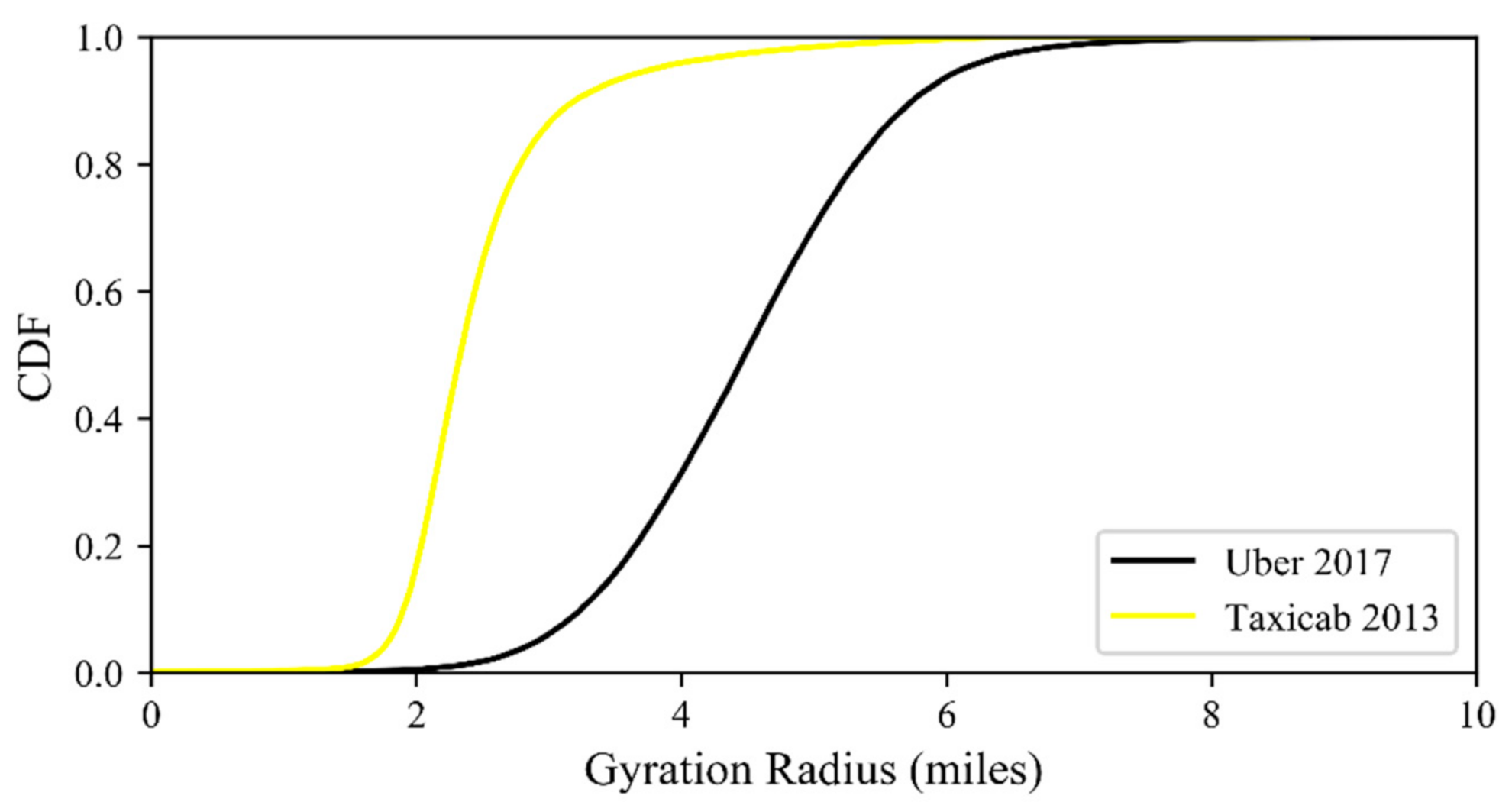

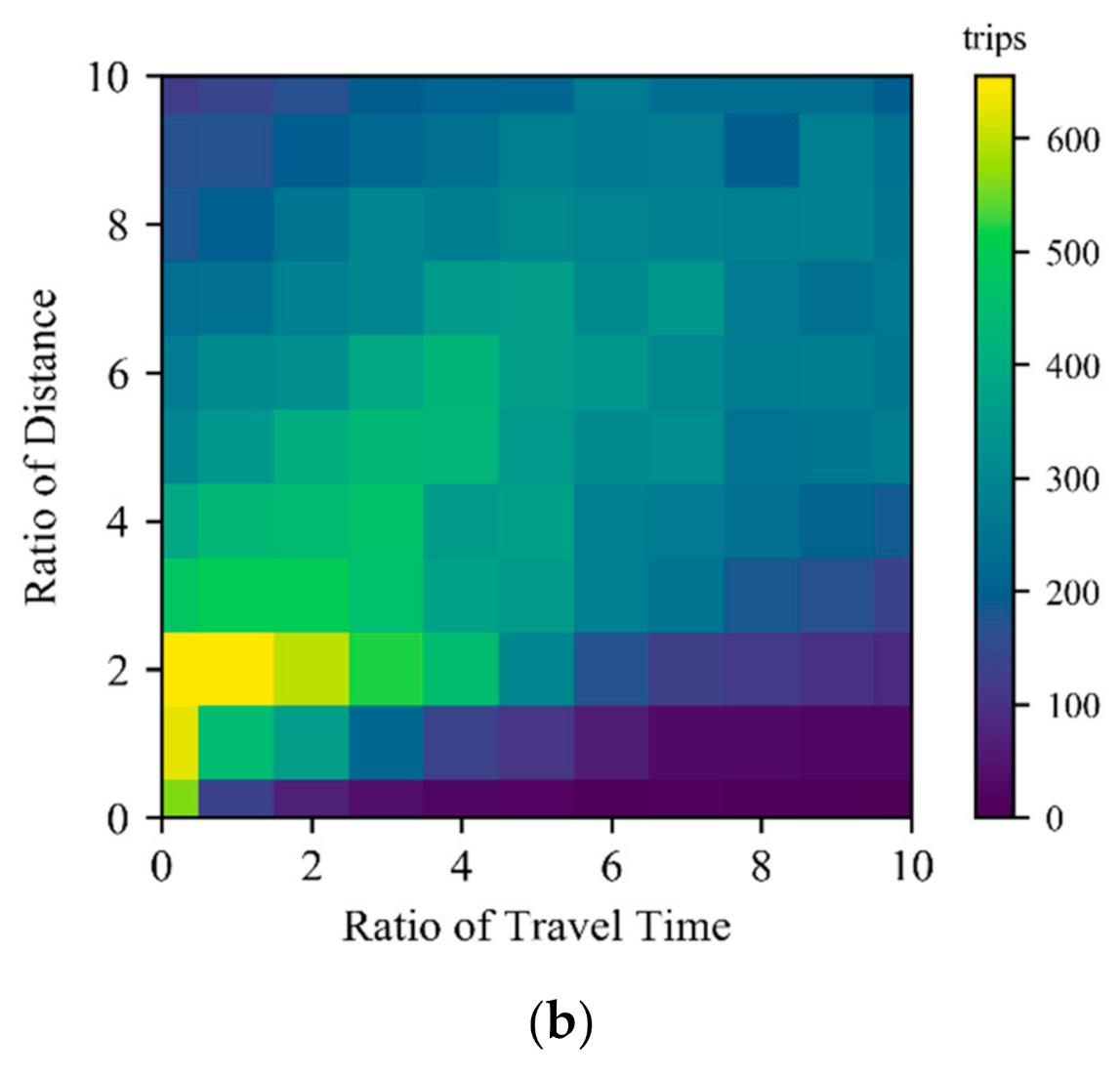
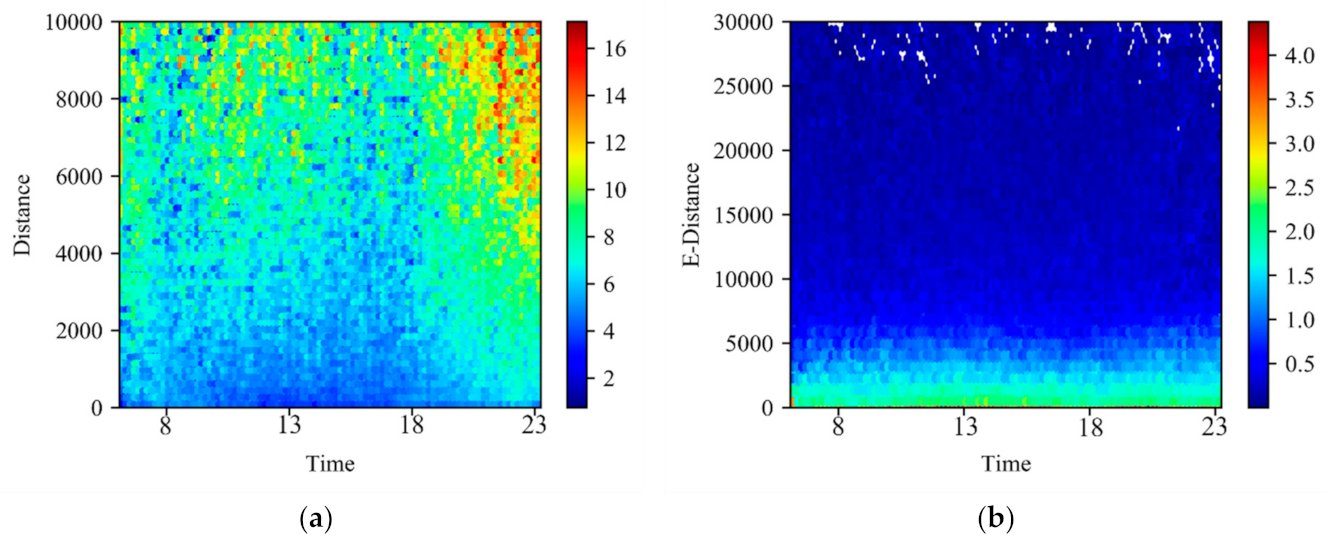
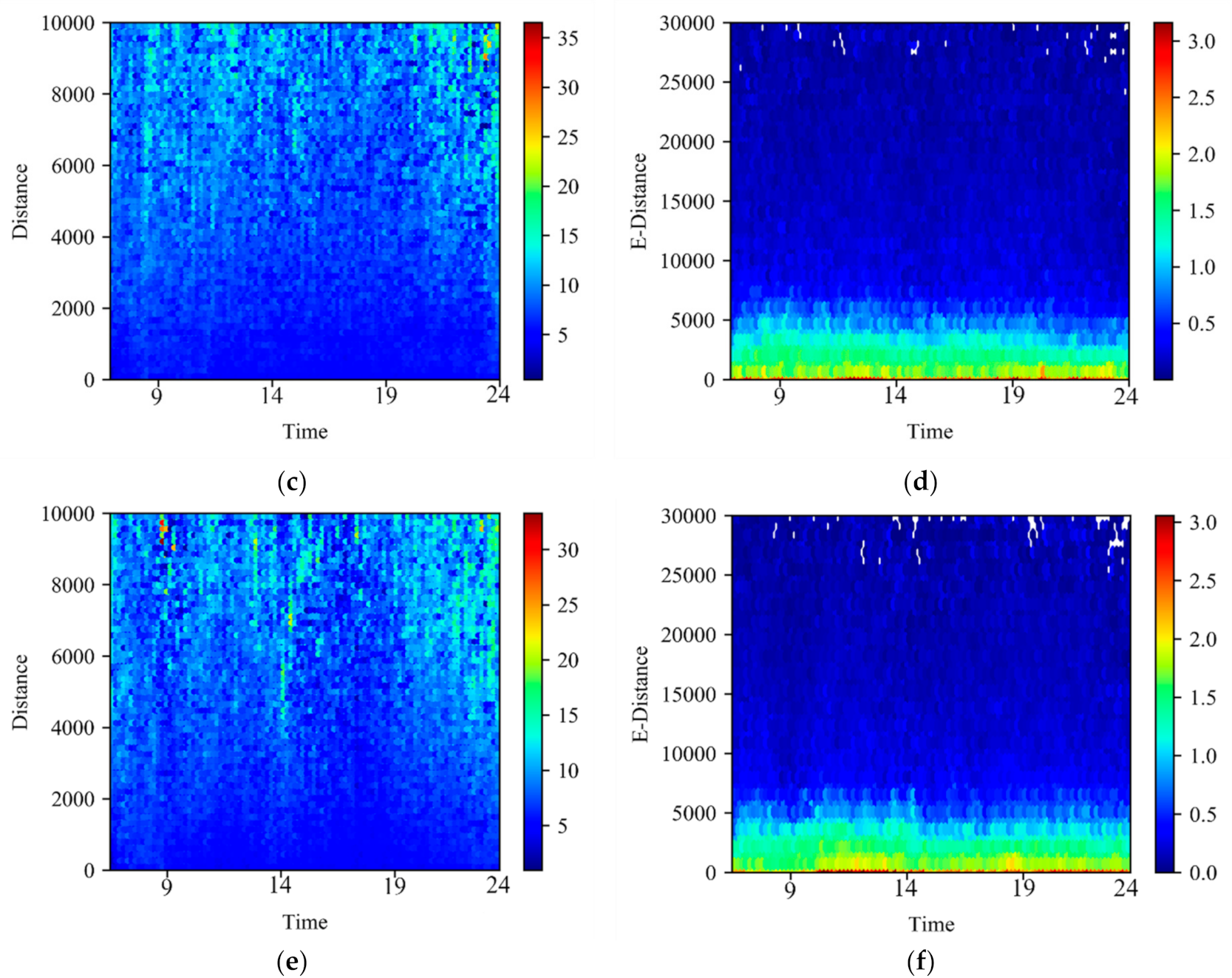
| Services | Duration | Records | Preprocessing |
|---|---|---|---|
| Yellow and Boro Taxicab | 2 April to 25 April 2016 | Occupied trips: | Occupied trip travel time: Occupied trip aggregation: , |
| Yellow Taxicab | 6 April to 29 April 2013 | Occupied trips: | Occupied trip aggregation: , Empty trips extraction: |
| UberX | 8 April to 1 May 2017 | Trajectory of empty vehicles: ; Surge pricing: | Uber empty trips: Uber occupied trips: |
Publisher’s Note: MDPI stays neutral with regard to jurisdictional claims in published maps and institutional affiliations. |
© 2021 by the authors. Licensee MDPI, Basel, Switzerland. This article is an open access article distributed under the terms and conditions of the Creative Commons Attribution (CC BY) license (https://creativecommons.org/licenses/by/4.0/).
Share and Cite
Zhang, W.; Xu, C. Exploring App-Based Taxi Movement Patterns from Large-Scale Geolocation Data. ISPRS Int. J. Geo-Inf. 2021, 10, 751. https://doi.org/10.3390/ijgi10110751
Zhang W, Xu C. Exploring App-Based Taxi Movement Patterns from Large-Scale Geolocation Data. ISPRS International Journal of Geo-Information. 2021; 10(11):751. https://doi.org/10.3390/ijgi10110751
Chicago/Turabian StyleZhang, Wenbo, and Chang Xu. 2021. "Exploring App-Based Taxi Movement Patterns from Large-Scale Geolocation Data" ISPRS International Journal of Geo-Information 10, no. 11: 751. https://doi.org/10.3390/ijgi10110751
APA StyleZhang, W., & Xu, C. (2021). Exploring App-Based Taxi Movement Patterns from Large-Scale Geolocation Data. ISPRS International Journal of Geo-Information, 10(11), 751. https://doi.org/10.3390/ijgi10110751







